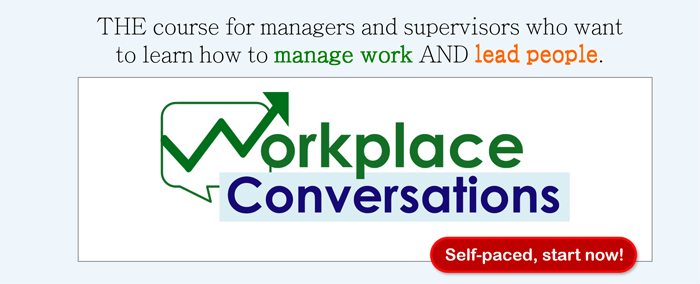Managers Set Expectations to Create Clarity

Leads, supervisors, and managers set expectations. There’s no way around this, despite the discomfort that may accompany this responsibility.
Frontline managers, especially those who work alongside their teammates, are often reluctant to set expectations. They’d rather assume everyone knows (it’s in the job description, right?), defer to upper management, or do more of the work themselves than “micromanage” or “be bossy.”
But if not the frontline manager, then who? Senior management can only issue generalized expectations like quotas, SOPs, and broadly defined outcomes. Step-by-step, day-to-day, employees need additional guidance on priorities and on how to break down the work for successful completion. There’s a huge gap when these expectations aren’t clear.
That’s the first problem. The second problem is that most frontline managers have never been trained on how to set expectations. They do it poorly if they do it at all.
The result is a resounding lack of clarity in most workplaces.
The Undeniable Advantages of Creating Clarity
Employees who aren’t sure what to do, how to do it, when or why are confused. Most try to figure it out on their own and operate with a vague discomfort, wondering if they’re doing what they should be doing and/or if they’re doing it right.
It’s disheartening to work hard, do your best, and complete a task… only to discover that what you’ve done wasn’t what was expected of you.
It’s fashionable these days to champion the competency called “dealing with ambiguity.” When employers fail to provide clear instructions, context, and a vision, they tell employees to figure things out on their own. Then, when employees figure wrong, employers hold it against them.
This is not fair, and it’s not productive. It’s lazy management.
Instead of foisting the “dealing with ambiguity” competency on employees, set a competency for all managers for “creating clarity.” That will make everyone’s jobs easier.
When people have clarity, they can:
-
See the path forward, looking farther into the future.
-
Make better decisions, moment-to-moment, to achieve the desired outcomes.
-
Go faster because they’re less burdened with ambiguity and guesswork.
-
Anticipate what’s needed and respond proactively.
-
Relax without a nagging doubt about whether or not they’re doing what’s best.
Clarity gives people confidence. Confident people are more courageous. They can work more autonomously and will feel a greater sense of accomplishment.
Teams that have clarity are nimble, self-assured, and highly effective. There is less infighting, more collaboration, and unity. Clarity gets people “on the same page.”
Organizations that create clarity become more efficient. There’s a higher degree of trust up, down, across and throughout these organizations.
The importance of clarity is well-defined in Patrick Lencioni’s book, The Advantage. He describes clarity as the foundation for organizational health. He postulates that clarity must start at the top and cascade throughout the organization.
But that doesn’t mean that managers should wait around for clarity to come from on high. Every manager should strive every day to provide clarity for employees and what’s expected of them.
Setting expectations creates clarity. Setting clear expectations helps employees navigate through the morass of choices and distractions they encounter each day.
There’s more to setting expectations, though, than issuing task assignments and “to do” lists. In fact, those assignments and lists might create more confusion than clarity.
Managers Set Expectations that Leave No Room for Doubt
An avalanche of assignments immediately invites doubt. What should I do first? How good is good enough when there’s this much work? Which of these tasks have implications for the other ones?
When faced with a heavy task load, human nature kicks in. People are inclined to select the tasks that are, for them, easiest and/or most enjoyable. They’ll choose tasks that are familiar and low risk.
Without clarity about priorities, they might not get to work that’s less familiar or less enjoyable. Certain tasks invite procrastination and the hope that somebody else will do it.
If tasks are not clearly assigned, there’s a chance that no one will do them. They’ll carry over from one shift to the next. The backlog eventually becomes problematic, and that’s where the finger-pointing and deflection kicks in. Excuses abound – not my job, not enough time, not fair… Soon, morale suffers.
When new tasks are delegated, panic sets in unless the delegation includes a clear set of expectations.
To be clear and complete, managers set expectations that answer all 10 questions on this list:
1. Who? Define who is involved, who is primarily responsible, who is consulted.
2. What? Describe the task or assignment, including the desired outcome.
3. How? Explain any required processes or quality standards expected.
4. When? Share the final deadline and deadlines for completion of milestones.
5. How Much? Set quantity expectations for volume of output or amount of progress.
6. What If Unable? Provide steps for handling obstacles or getting additional support.
7. What If Not Done? Detail the consequences for incomplete or unacceptable work.
8. What If Done Well? Incentivize, when appropriate, with clear rewards/recognition.
9. Why? Offer context and a big-picture perspective by sharing the reason for the work.
10. Why Me? Give your rationale for selecting this individual for this particular assignment.
These questions will not be asked. People usually don’t pursue clarity because it’s been implied that they should know or figure it out on their own (“dealing with ambiguity”). Nevertheless, it’s a manager’s job to anticipate the need for these answers and to proactively provide this clarity.
Here’s an example of well-set expectations, clarity, and an employee who’s set up for success:
“Ana, I would like you to oversee cleanup on the floor this week. I’ll ask others to chip in and maintain their individual areas, but I need you to allow time at the end of your shift for walking the floor and handling any clean up and basic prep for the next shift.
This includes making sure that the patient rooms are sterile and that the hallways are clean. The bathrooms need to be clean. I’d also like you to check the basic inventory on supply carts. What I’m looking for is detailed on the ‘Shift End Duties’ checklist, and I’m counting on you for quality assurance.
Although others will participate in completing these tasks, as always, we need to have one person who’s accountable to make sure we don’t let any of these important duties fall through the cracks. I’d like you to check at mid-shift and one hour before shift change so that you can alert others to any gaps you see. At the end of the shift, nearly all of the tasks should already be completed. If that’s not the case, please document that for me so I can have follow-up conversations with others.
It is not my intention for you to work overtime. You’ll be relieved of other floor duties for the last hour of the day so that you can focus on these tasks. If you are unable to complete the volume of work in that time, let me know the next day and give me specifics so we can continually improve on this plan.
I see this as a growth opportunity for you. You’ve expressed interest in being considered for a Lead role, and this will help me understand your approach to overseeing workflow and documenting progress. I’m also relying on you for this because I appreciate your high standards and know I can count on you to do the best possible job in preparing the floor for the third shift to come on duty.”
Review this example to see the 10 elements of clear expectations. Contrast this to expectations you’ve set so you can identify opportunities for making your expectations clearer and more complete
Keep It Going! It’s Not One & Done with Expectations
Expectations occasionally need reiteration, reinforcement, and refinement.
Many a manager has expressed disappointment when an employee didn’t fully meet their expectations after just one round of explaining those expectations. Keep in mind that we all have cognitive limitations, and that we may need to hear something more than once to fully understand and retain it. If it’s important (and expectations are!), then you should plan to talk about it more than once.
Most employees are besieged daily with emails, texts, Slack Channel messages, calls, voice mails, meetings, and more communication than any one person can remember and respond to. While we’d like to believe that employees hang on every word a manager utters, that’s simply not realistic. For important messages, the safer bet is to say it too often rather than not saying it often enough.
It’s not uncommon for a manager to set expectations that contradict previous expectations. That’s no good! For example, “This is the top priority” is an expectation that can only be set once. As soon as even two things are “the top priority,” neither one really is.
Any change can impact expectations. New team members influence workflow and, hence, expectations may need to be adjusted. Similarly, new systems or processes or technology will require a review of expectations and a reset may be warranted.
As people grow in their competence and confidence, expectations should expand. You expect more from the 10-year veteran than you do from the new hire. But it’s unfair to leave those expectations unspoken. Rather than assuming the veteran will step up and meet those unspoken expectations, lay them out clearly and completely. Better yet, engage veterans in setting new expectations for themselves.
What’s more, expectations change as the situation changes. Maybe there’s a better way. Maybe there’s duplicative effort or unnecessary steps that could be trimmed. In those cases, no need to hold fast to expectations that are counterproductive.
This is not, however, a license to micromanage every detail related to delivering the end result. If there are some steps or processes that are unimportant, be okay with employees making their own choices about how to do the work. Your expectations and reiterations should be focused on what’s non-negotiable and absolutely essential.
Managers set expectations so that employees have clarity and can deliver what’s needed. If you’re not setting clear and complete expectations, employee underperformance may be a result of what you failed to do.
